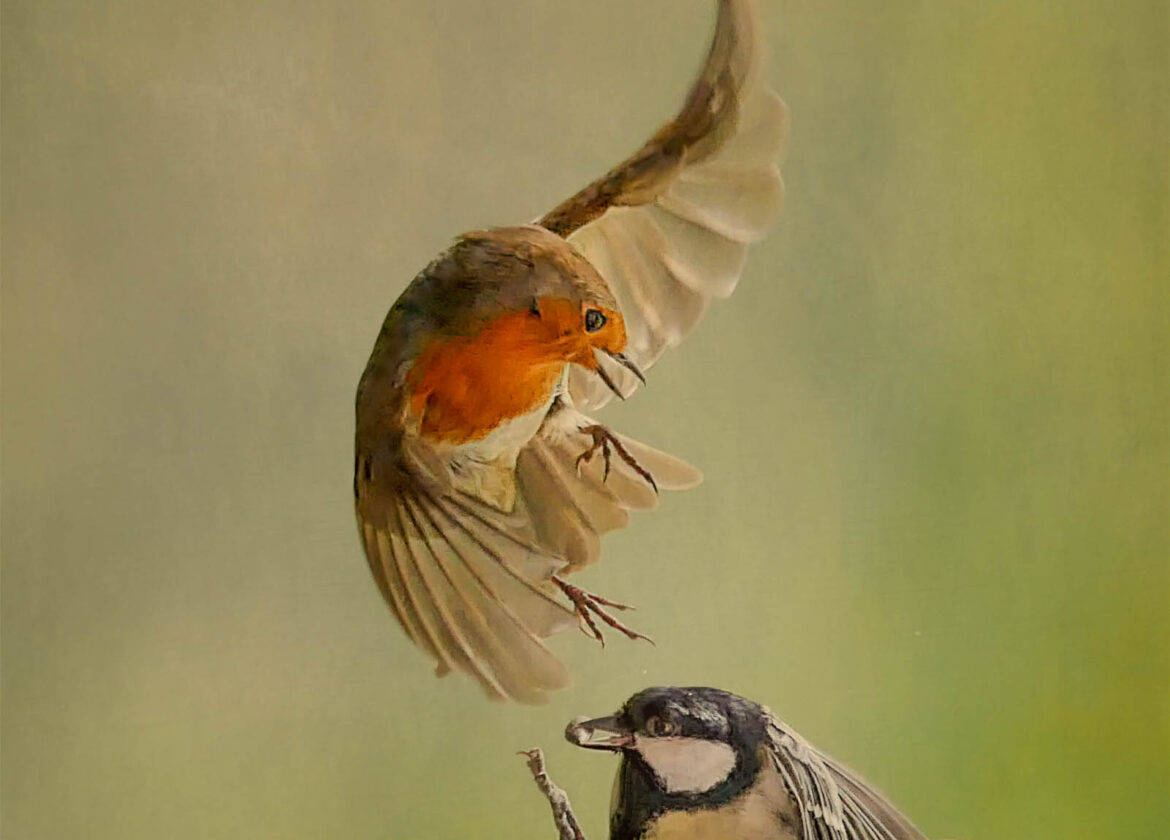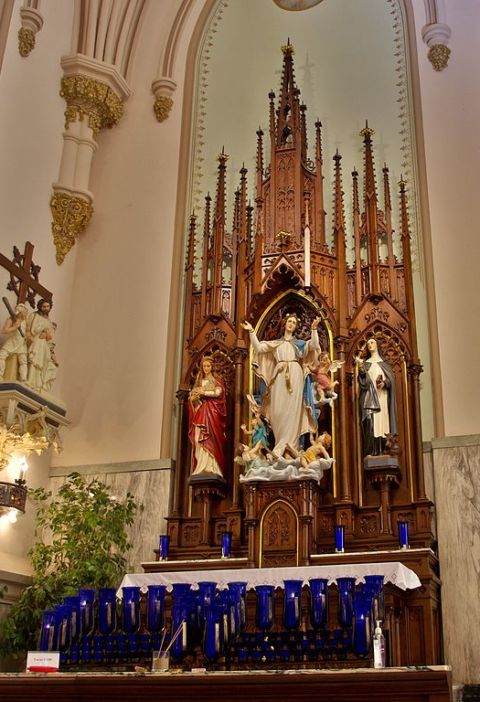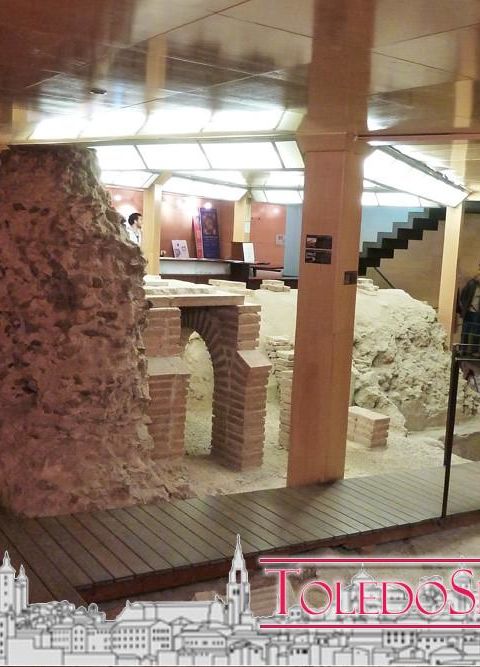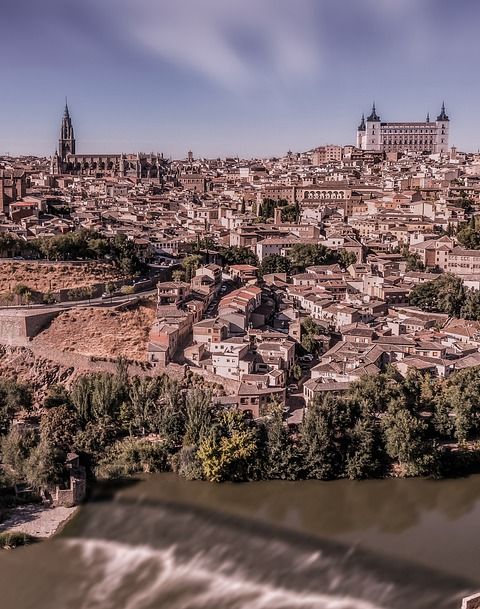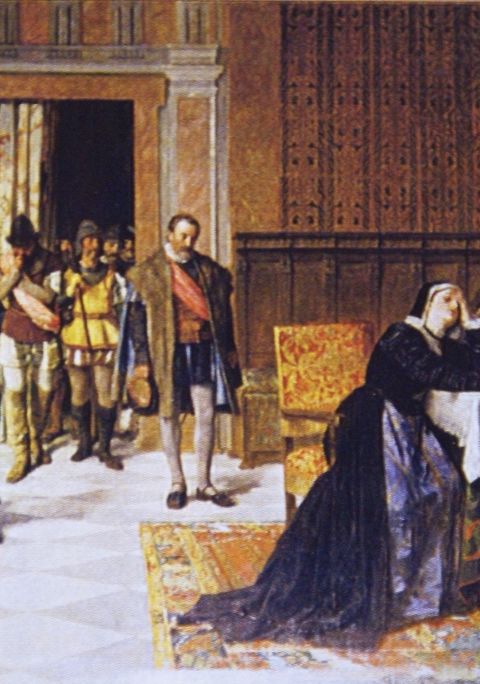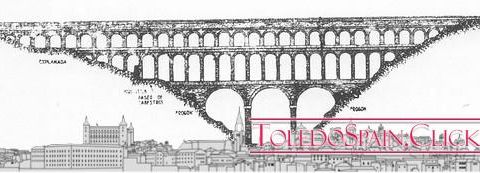Toledo Cathedral has a dozen or so organs, if I don’t leave any. They are the following: the General, the Echevarría, Verdalonga, the Mozarabic Chapel, the two of the Chapel of the New Kings, the Chapel of the Virgin of the Alcázar, the Chapel of the Virgin of the Tabernacle, the Chapel of St. Peter and the Organ of the Emperor. An article by Francisco Javier Martín Fernández.
Interior of the Lions Gate, Organ of the Emperor and Gothic rose window. Toledo Cathedral. Photograph corresponding to an old postcard from 1960 made by Luis Arribas and belonging to the Municipal Archive of Toledo.
This organ, which is the one we are dealing with today, is undoubtedly the most spectacular of all, as well as the most important. It is located in the south arm of the transept, on the inner side of the Lions Gate, with which it shares not only a wall but also a plateresque style, like a stone and imposing altarpiece.
Just to the right, as seen from inside the Cathedral, is the enormous painting of San Cristobal (popularly known as “San Cristobalón” ), decorating a wall behind which is the musical archive of the Cathedral. Precisely between San Cristóbal and the interior of the Puerta de los Leones there is a beautiful little door that leads to the Emperor’s Organ.
The interior of the Lions Gate is designed in plateresque style, although there are still clearly Gothic elements in its lower body. It was the work of Alonso de Covarrubias, who made a double door divided by a mullion and crowned with a historic tympanum, whose motif is the tree of Jesse. Both the resurrected one that appears in the mullion and the tympanum are previous works to the rest, having been created in Gothic style by Hanequín de Bruselas in 1460.
Sure you’re also interested: 21 monuments and must-see places to visit in Toledo (Updated)
The leaves of the doors (and their boards) were carved in walnut wood by Miguel Copin (son of Diego Copín), with the collaboration of Diego Velasco and Anas (1541).
In the niche on the left there is a small mausoleum in which lies Canon Alonso de Rojas, who died in 1577, while the niche on the right remains empty.
Above the door is a second body with a large medallion representing the Coronation of the Virgin, the work of Gregorio de Borgoña, framed between the statues of David and Solomon, the work of Miguel Copín.
In the upper body we finally find the Emperor’s Organ, which is the oldest of the organs existing today in the Cathedral and was built by the master Gonzalo Hernandez de Cordoba (although it was finished by the Toledo Juan Gaytan) between the years 1543 and 1549.
A beautiful gothic rose window completes the ensemble.
The Emperor’s Organ was repaired in later centuries, and several registers were added to it, although, except for those modifications, the organ as we know it today hardly differs from that created in the time of Charles V.
Alberto Merklin described the organ in detail in his book “Organology” written in 1924. According to Merklin, it consists of “two 45-key manual keyboards, with short octave, and 13 double keys on the bottom bracket (natural tones with all sharps).
This idea of double keys is an invaluable resource, as pressing one half of the key only sounds the tongue registers of the bottom bracket that are removed. When you step on the other part of the key, the flutes sound, and of course, when you step on both keys, the feet sound tongue and flutes. This was at that time a transcendental innovation for organic music, being able to emphasize or not that “cantus firmus” without opening each time the registers. The “Piano automatic pedal” is what in the modern organ replaces this invention of the double keys in the bottom bracket”.
I’m sure you’re also interested in: Godulfo (The Chasuble of a Saint)
Leaves, mullion and tympanum on the inside of the Lions Gate of Toledo Cathedral. Photograph of Casiano Alguacil belonging to the photographic collection of this author property of the Municipal Archive of Toledo.
Merklin deepens in his book in the detailed description of the organ, which he considers very original, in the following way:
” The registers, as in all the old Spanish organs, are split, i.e. treble and bass, right and left. (For ease of reference we quote the complete records):
Bottom keyboard: one flute of 26 (16 feet), one flatuado of 13 (8 feet), one violon of 26 (16 feet) and octave (4 feet).
Exterior tongue of the keyboard below (added in the 18th century): royal trumpet (8 feet), field clarinet (4 feet), clear clarinet (4 feet), shiny clarinet (2 and 4 feet), and magna trumpet (16-foot treble).
Keyboard above: flute of 13, flute of 26, violon of 13, octave, covered octave, transverse flute (tiples), fortnight (2 feet), dozen and fortnight (2 2/3 and 2 feet), nasardos of 8 per point, nasardos of 5 per point, full of 8 per point and corneta magna.
Top keyboard trumpet: royal trumpet, trumpet magna (tiples), bassoon and clarinet (4 and 8 feet) and violet (bass).
Cons: sound over the first half of the bottom bracket key: 52 (32 feet) cons, 26 (26) cons on the façade, 13 (13) cons and octave (4) cons. They sound on the second half of the bottom bracket: cons in fortnight (2 feet), cons in 22ª (1 foot), cons in bombardas (16 feet), cons in clarines and clarines in fortnight (2 feet).
This organ carried neither couplings nor expressive box nor tremolo.”
Bibliography:
<font color=#38B0DE>-=www.catedralesgoticas.es=- Proudly Presents
” Evolution of the Spanish organ: XVI-XVIII centuries”, by Louis Jambou. 1988.
” Organology,” by Alberto Merklin. 1924.
<font color=#38B0DE>-=http://www.jdiezarnal.com/catedraldetoledo.html=- Proudly Presents
(Note: none of the images illustrating this article belong to the collection of Francisco Javier Martín Fernández)
Published by permission of its author: Francisco Javier Martín Fernández (see original post)

